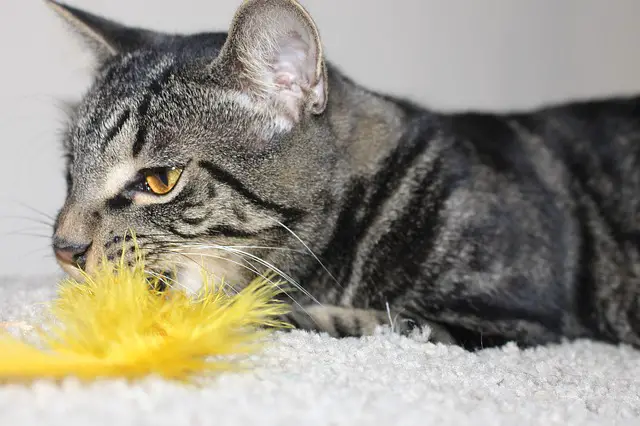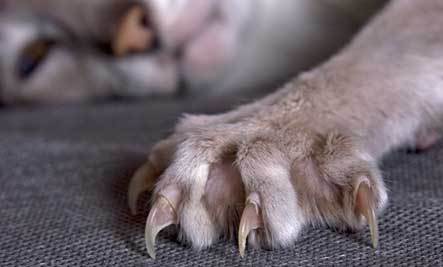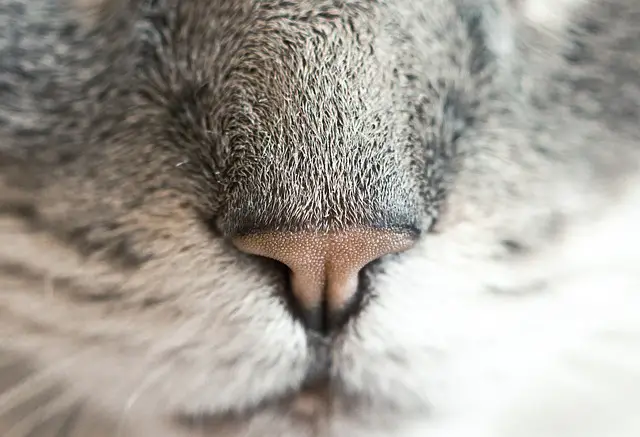
There he is…quietly studying his prey. Observing. Stalking. Analyzing its every move…until the time comes to POUNCE! The mighty predator jumps upon the back on his helpless prey and basks in the glory of a battle well won.

Okay, sure. The prey is the tiny feather mouse toy that you bought from the pet store this week and the mighty predator is your cat. While it might seem like this innocent and entertaining act of predator and prey is a form of playing for your cat, the truth is that it speaks to the very essence of your cat’s animal nature.
To you, your cat is a loving playmate and cherished family friend.
To your cat, he is a hunter and a predator by nature, and those feelings must be allowed to be expressed for your cat to truly be happy and healthy.
Your cat is a BEAST!
No. Really. He is. According to a recent study done in collaboration with China and Republic of Korea, the common house cat shares 95.6% of the DNA with Siberian Tigers. Almost 96% of your eighteen inch, fifteen pound house cat’s genomes are identical to that of a twelve foot, seven hundred pound wild animal that hunts its food and survives on instinct and shear power.

While the evolutionary path of the common house cat and the tiger split off nearly 11 million years ago, the DNA that binds the two together is still phenomenally strong. That means that your little buddy Mr. Fluffy is not only your best reading buddy and cuddle partner, but he is also an ancient pre-programmed killing machine designed to hunt and destroy his pray and climb high trees for safety.
You can take the cat out of the wild…but you can’t take all the wild out of the cat.
The science behind domestication is a fascinating one. When humans started the process of domesticating cats, their genetic makeup began to change, some of those changes happened rapidly. Among the most significant changes in the genomes of a house cat compared to their wild cat ancestry is their size, their weight, their coat texture, and facial structure. Their domesticity also altered how docile they are and the types of disease they are susceptible to. House cats have experienced genetic mutations on genes that determine their aggression, their ability to form memories, and their ability to learn and control behaviors through fear or reward based stimuli.
That being said, the number of things that stayed the same far outweigh the things that have changed in the genetic makeup and instincts of your furry friend.

Both your cat and their wilder counterparts share an innate drive and desire to hunt. Kittens are born as carnivores and are built to consume meat, just like their wild relatives. House cats, just like their tiger brethren, possess a specific fat-metabolizing gene mutation that is designed to give them the ability to better animal protein that is fatty. House cats have also retained their heightened sense of smell and hearing, both of which are better than most carnivores. In particular, the house cat continues to have the exceptional night vision that his wild cat cousin from millions of years ago gave him. Other (more annoying) traits that your kitty can thank his ancestors for? Scent marking and table scratching.
Feed the beast!
In order for your cat to be at his happiest and most fulfilled, you need to be ready to feed his wild side, literally and figuratively.
Following are 5 tips on how to let your kitty be the wild thing he is destined to be, while maintaining your sanity (and furniture).
#1. Make Time for Play
One of the best things you can do for your cat to feel out his wild side is to let him play. Buy toys that encourage him to pounce, stalk, and battle his prey. Items such as feathers, toy mice, or even laser pointers are a great method for your cat to get his animal instincts out.

#2. Invest in a Scratching Post
In the wild, cats use trees to scratch as a means to sharpening their claws. Having sharp claws can mean the difference between getting lunch or being lunch in the wild. Sure, your cat doesn’t have to fight for his next meal, but his bloodline doesn’t know that yet. With that in mind, he is going to want to sharpen his claws some something, and you’re probably well aware that this ‘something’ is often your furniture. A scratching post or pad is a great way to let your cat get his claws sharp while keeping your table legs in tact.

#3. Try Pheromones
Scent marking. It is not always pleasant. Actually, it is almost always unpleasant. However, much like the claw sharpening, your cat has a deep seated need to mark his territory. Thankfully, products that include artificial pheromones are on the market and can help reduce the amount of markings your cat might be inclined to make. These pheromones also possess a great ability to help calm down your furry family member and reduce their stress.

#4. Let ’em Get High
Your cat is eager to get up into high places, and will do so whether you want him to or not. Cats use high perches to both escape predators and seek prey. High spaces represent safety, stability, and sustainability to your cat and their wild relatives. It is in your cat’s nature to find high places to perch, and if you do not create a space for him to do so, he will take it upon himself to make one. (Sometimes this results in knocked over plants or torn curtains.) Create a high space for your cat to tap into his wild side.

#5. Feed Her Wild Side
As we previously mentioned, your cat is a born and bred carnivore with the biological resources to efficiently consume fatty animal protein. It might seem simple, but feeding your cat a good quality meat is one of the most surefire ways to ensure his happiness and health.

So the next time your feline fur-baby acts a little ‘wild’ … you’ll know why.
“God made the cat in order that humankind might have the pleasure of caressing the tiger.” ~ Fernand Mery



